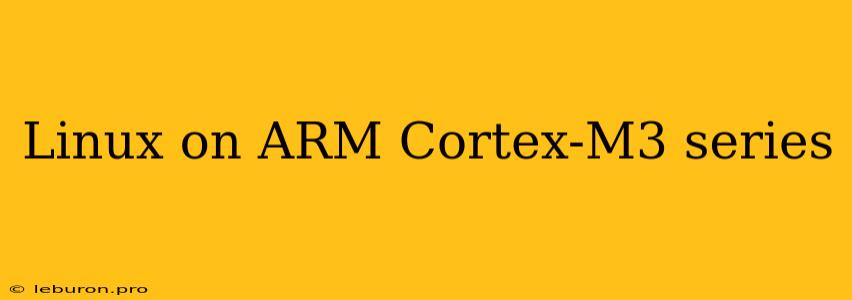The rise of embedded systems has been accompanied by a growing need for versatile and powerful operating systems. While traditional embedded systems often relied on proprietary real-time operating systems (RTOS), the open-source nature and robust features of Linux have made it increasingly popular in this domain. Linux on ARM Cortex-M3 series has emerged as a compelling solution, offering a compelling combination of flexibility, performance, and community support. This article will delve into the nuances of running Linux on ARM Cortex-M3 series microcontrollers, exploring its advantages, challenges, and key considerations for developers.
The Power of Linux on ARM Cortex-M3
The ARM Cortex-M3 series has become a ubiquitous choice for embedded systems, thanks to its balance of performance and energy efficiency. These microcontrollers feature a 32-bit ARM architecture, enabling them to handle complex tasks with relative ease. Linux on ARM Cortex-M3 series takes advantage of this powerful platform by providing a rich ecosystem of software tools and libraries that are typically associated with larger, more complex systems.
Benefits of Running Linux on Cortex-M3
- Open-Source Ecosystem: Linux's open-source nature fosters a vibrant community of developers who contribute to the kernel, drivers, and applications. This accessibility lowers the barrier to entry for newcomers and enables developers to leverage existing code and solutions.
- Rich Functionality: The Linux kernel provides a comprehensive set of features, including networking, file systems, memory management, and process management. This extensive functionality allows for the creation of sophisticated embedded applications.
- Hardware Abstraction: Linux offers a consistent abstraction layer, shielding developers from the complexities of specific hardware implementations. This simplifies the development process, enabling code to be easily ported across different Cortex-M3 devices.
- Power Management: Linux integrates with the power management features of Cortex-M3 microcontrollers, allowing for optimized energy consumption and extended battery life.
- Security: The Linux kernel includes security features like user-space isolation and access control mechanisms, enhancing the robustness of embedded applications.
Navigating the Challenges of Running Linux on Cortex-M3
While Linux on ARM Cortex-M3 series presents several advantages, there are also challenges to consider:
Memory Constraints:
Cortex-M3 microcontrollers typically have limited memory resources compared to traditional desktop or server systems. Running Linux on these devices requires careful resource management and optimization. Developers must select suitable memory-efficient applications and libraries, and potentially explore techniques like memory compression.
Performance Considerations:
While Cortex-M3 microcontrollers are powerful, they still fall short of the processing capabilities of higher-end ARM architectures. Some embedded applications might experience performance limitations when running on Linux. Strategies like code optimization, task scheduling, and real-time extensions can help mitigate these concerns.
Real-Time Performance:
Real-time applications, which demand precise and predictable responses, can pose challenges when running Linux on Cortex-M3. The Linux kernel is not designed for hard real-time applications by default. Developers might need to explore real-time extensions or consider using an RTOS for highly critical tasks.
Choosing the Right Linux Distribution for Cortex-M3
Several Linux distributions have been tailored for embedded systems, offering optimized kernels and tools for Cortex-M3 development. Popular options include:
- Yocto Project: A powerful framework for building custom Linux distributions, often used for complex embedded projects. It offers flexibility in selecting components and configuring the kernel.
- Buildroot: A simpler alternative to Yocto, providing a streamlined build process for creating embedded Linux distributions. It offers a pre-configured set of packages for Cortex-M3 targets.
- OpenWrt: Primarily known for its use in routers, OpenWrt can also be used for embedded development. It provides a comprehensive package management system and a user-friendly interface.
- Debian ARM This Debian branch provides packages specifically for ARM architectures, including support for Cortex-M3 microcontrollers.
Implementing Linux on ARM Cortex-M3 series
To successfully run Linux on a Cortex-M3 device, developers need to consider the following steps:
- Target Selection: Choose a Cortex-M3 microcontroller with sufficient resources and supported by the chosen Linux distribution.
- Distribution Selection: Select an appropriate Linux distribution, considering the required features, build process, and target hardware.
- Kernel Configuration: Configure the Linux kernel for the specific Cortex-M3 device, including device drivers, memory management, and other relevant settings.
- Cross-Compilation: Build the Linux kernel and applications on a host system, targeting the Cortex-M3 architecture.
- Flashing: Flash the compiled Linux image to the Cortex-M3 microcontroller.
- Boot and Run: Power up the device, allowing the Linux kernel to boot and run the desired applications.
Debugging and Testing
Developing embedded systems with Linux on Cortex-M3 can present unique debugging challenges. Techniques like:
- Serial Console: Provides a text-based interface for interacting with the Linux kernel and applications.
- GDB: A powerful debugger that can be used to inspect the running process and memory state.
- JTAG Debugger: Offers a hardware-based debugging interface, providing access to internal registers and memory.
Testing is crucial to ensure the stability and functionality of Linux on ARM Cortex-M3 series applications. A range of testing methodologies, including:
- Unit Testing: Focuses on testing individual software components in isolation.
- Integration Testing: Verifies the interaction between different software modules.
- System Testing: Evaluates the performance and functionality of the entire system.
Linux on ARM Cortex-M3 series - A Promising Future
Linux on ARM Cortex-M3 series is a testament to the versatility and adaptability of the Linux operating system. It empowers developers to build sophisticated embedded applications with a robust and mature software ecosystem. The open-source community, coupled with the increasing availability of hardware platforms, positions Linux on ARM Cortex-M3 series as a promising solution for a wide range of embedded applications, contributing to the continued growth and innovation in this domain.
